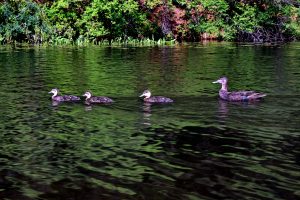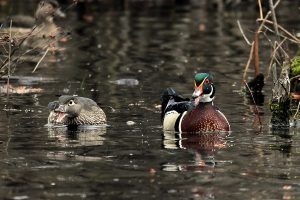by Christopher Dennison, Municipal Policy Intern

Mallard Duck family (Simon Lunn).
The wellbeing of waterbirds is naturally intertwined with the health of shoreline and riparian ecosystems; the Ribbon of Life that surrounds our freshwater lakes and rivers. In North America, ecologists have posited that the riparian zone (the transitional area of land directly adjacent to a watercourse) supports a much higher diversity of nesting birds than uplands due to specific habitat characteristics (Sanders & Edge, 1998; Carothers, 1977).
The removal of native vegetation adjacent to watercourses, whether lakes, rivers, or streams, has a direct and negative impact on wildlife. According to Dr. Steven Carothers (1977): “[…] when a riparian habitat is removed or severely manipulated, not only are the riparian species of the area adversely influenced, but wildlife productivity in the adjacent habitat is also depressed.” (p. 3).
Being at the interface between aquatic and terrestrial ecosystems, the riparian is a critical area of refugia and breeding for a diversity of species that use both aquatic and terrestrial habitats. Unfortunately, these habitats, and the vegetation within them, are often degraded as a result of shoreline development.
Many species of waterfowl are well-adapted to development on shoreline areas, and readily use aquatic habitats located in urban areas with higher levels of human disturbance (Traut & Hostetler, 2004). For example, the highly familiar and charismatic Mallard (Anas platyhynchos) is more well-adapted to developed lands than similar dabbling ducks like the Black Duck (Anas rubripes) (Bleau, 2018; Nummi et al., 1994).
Moreso than human occupation, certain onshore and littoral habitat characteristics, such as degree of canopy cover and diversity of understory plants (and subsequent food supply), impact the abundance of certain waterfowl, whether dabbling or diving ducks. This signifies that the presence or absence of certain habitat characteristic (e.g. woody vegetation, sources of food) have more of a role to play in waterbird abundance than does the presence of humans: “[…] many waterbirds [are] willing to tolerate increased levels of human disturbance in response to the favorable habitat found along developed shorelines” (Traut & Hostetler, 2004, p. 79).
Oftentimes, it is the type of development that matters more for waterfowl. In many instances, a shoreline might be considered “developed” based merely on the presence of human-made structures and dwellings (Traut & Hostetler, 2004). However, there are countless ways that humans can happily co-exist with and even benefit waterbirds on their shoreline property, specifically through the provision of suitable habitat, food, and nesting opportunities. This starts with the planting and conservation of native shoreline vegetation.
For example: “The basic breeding habitat requirements of Wood Ducks are nesting cavities and adjacent wetland habitat containing trees, shrubs, or dense herbaceous vegetation that provide cover and an abundance of aquatic insects for ducklings” (Davis, n.d.).

Wood Duck pair (Simon Lunn).
Nest-site specialists (e.g. Wood Duck) and piscivorous species (e.g. Bufflehead and other diving ducks) may be negatively impacted by the removal of woody and herbaceous vegetation since these natural habitat features are relied upon for nesting and foraging (Hickie, 1985; Wagner, Haack, & Korth, 2003; Castelle, Johnson, & Conolly, 1994; Dick, Smith & Smart, 2004; Nummi & Pöysä, 1995).
Submerged aquatic vegetation that is found more readily on undisrupted shorelines and riparian areas are critical food sources for foraging waterfowl (Sibilia et al., 2022). Beyond this, the water quality and clarity benefits that emerge from maintaining native shoreline vegetation also promote waterfowl use (Sibilia et al., 2022).
The clearing of vegetation on or near riparian ecosystems has a cascade of potentially negative impacts that effect waterfowl and other wildlife. Shoreline development and occupation need not coincide with the degradation of waterfowl habitat. Sustainable shoreline landscaping and land- use practices that allow for recreational use and gorgeous views are achievable with informed planning and can ensure that homeowners are able to enjoy their lake or river without destroying the habitat characteristics upon which many species rely. It is important that property owners become cognizant of the fact that a living on a shoreline is not only a personal or recreational opportunity, but also an opportunity to preserve ecosystems that allow incredible waterbirds to thrive.
Sources
Bleau, A.J. (2018). Comparative Habitat Selection And Behavior Of Mallards (Anas Platyrhynchos) And American Black Ducks (Anas Rubripes) Wintering In The Finger Lakes Region [Unpublished Master’s Thesis]. Department of Environmental and Forest Biology, State University of New York. Retrieved from: https://core.ac.uk/display/233604420?source=2
Carothers, S.W. (1977). Importance, Preservation, and Management of Riparian Habitats: An Overview. In Importance, Preservation and Management of Riparian Habitat: A Symposium, USDA Forest Service, General Technical Report RM-43, Tucson, AZ., 1977, pp. 2 – 4. Retrieved from: https://www.fs.usda.gov/rm/pubs_rm/rm_gtr043.pdf.
Castelle, A.J., Johnson, A.W., & Conolly, C. (1994). Wetland and Stream Buffer Size Requirements—A Review. Journal of Environmental Quality, 23(5), 878 – 882. https://doi.org/10.2134/jeq1994.00472425002300050004x.
Davis, J.B. (n.d.). Understanding Waterfowl: Wood Duck Box Management: With regular maintenance, manmade nesting structures can increase local production of these beautiful birds. Ducks Unlimited. Retrieved from: https://www.ducks.org/conservation/waterfowl-habitat/understanding-waterfowl-wood-duck-box-management.
Dick, G.O., Smith, J.K., & Smart, R.M. (2004). Migratory Waterfowl Habitat Selection in Relation to Aquatic Vegetation (ERDC/TN APCRP-EA-09). US Army Corps of Engineers. Retrieved from: https://apcrp.el.erdc.dren.mil/elpubs/pdf/apcea-09.pdf.
Hickie, J. (1985). Habitat Management Guidelines For Waterfowl In Ontario for use in Timber Management (MNR No. 51606). Ontario Ministry of Natural Resources. ISBN 0-7794-2355-0.
Nummi, P. & Pöysä, H.. (1995). Habitat use by different-aged duck broods and juvenile ducks. Wildlife Biology, 1(3), 181 – 187. https://doi.org/10.2981/wlb.1995.017.
Nummi, P., Pöysä, H., Elmberg, J., & Sjöberg, K. (1994). Habitat distribution of the mallard in relation to vegetation structure, food, and population density. Hydrobiologia, 279, 247 – 252. https://doi.org/10.1007/BF00027858.
Sanders, T.A. & Edge, W.D. (1998). Breeding Bird Community Composition in Relation to Riparian Vegetation Structure in the Western United States. The Journal of Wildlife Management, 62(2), 461 – 473. https://doi.org/10.2307/3802320.
Sibilia, C.D., Aguirre-Gutiérrez, J., Mowbray, L., & Malhi, Y. (2022). Effects of submerged aquatic vegetation and water quality on waterfowl abundance by foraging guild. Ecological Solutions and Evidence, 3(1), e12137. https://doi.org/10.1002/2688- 8319.12137.
Traut, A.H. & Hostetler, M.E. (2003). Urban Lakes and Waterbirds: Effects of Development on Avian Behavior. Waterbirds: The International Journal of Waterbird Biology, 26(3), 290 – 302. https://www.jstor.org/stable/1522410.
Wagner, C., Haack, J., & Korth, R. (2003). The Shoreland Stewardship Series Number 3: Protecting Our Living Shore (UWEX PUB-GWQ039 – DNR PUB-WT-764 2003). University of Wisconsin. Retrieved from: https://dnr.wi.gov/topic/ShorelandZoning/documents/WT-764.pdf.
This blog post is part of a series generously funded by Wildlife Habitat Canada’s Canadian Wildlife Habitat Conservation Stamp Program.
